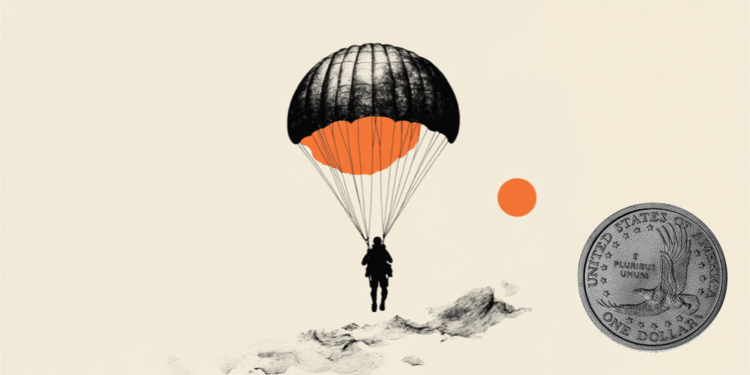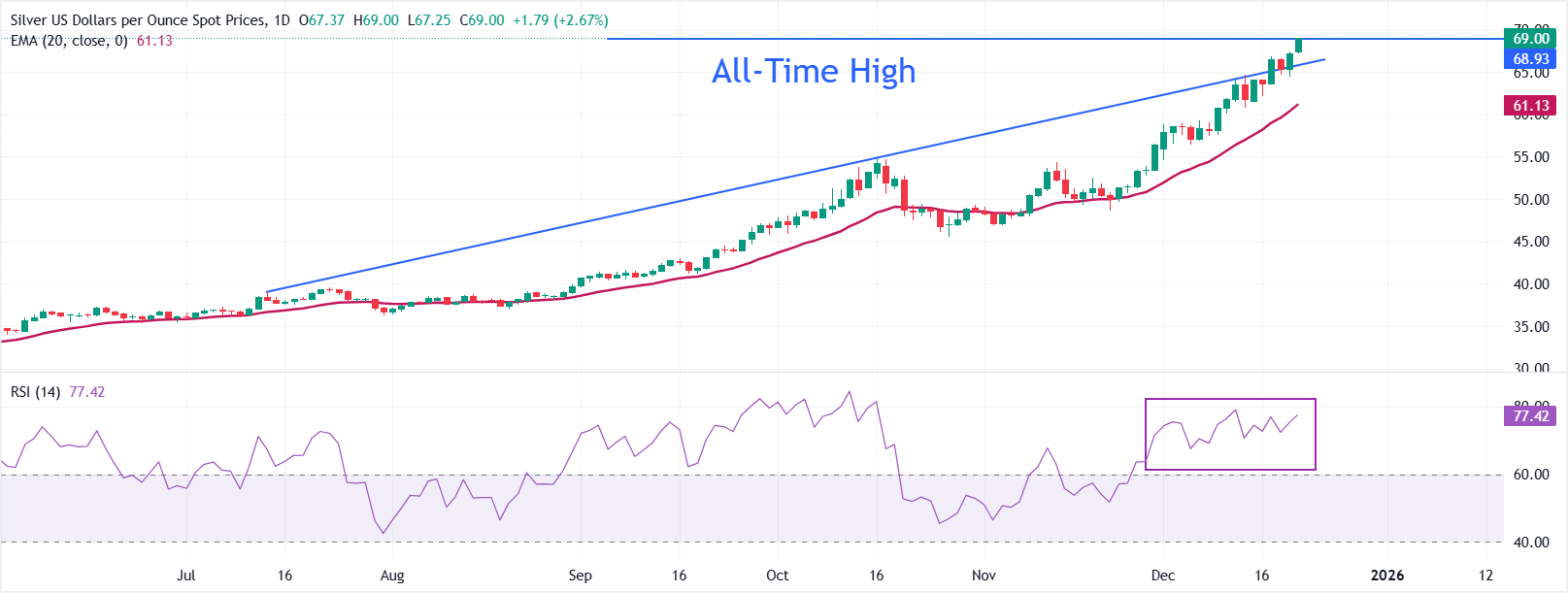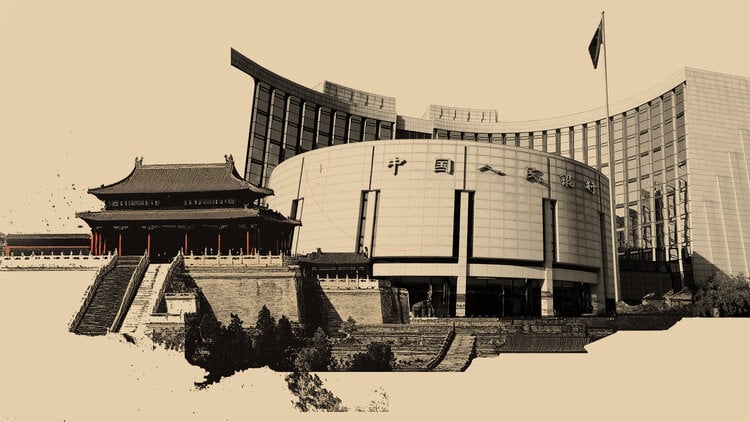Forex News

Gold prices rose in India on Monday, according to data compiled by FXStreet.
The price for Gold stood at 12,658.96 Indian Rupees (INR) per gram, up compared with the INR 12,499.52 it cost on Friday.
The price for Gold increased to INR 147,651.60 per tola from INR 145,791.90 per tola on friday.
Unit measure | Gold Price in INR |
|---|---|
1 Gram | 12,658.96 |
10 Grams | 126,589.70 |
Tola | 147,651.60 |
Troy Ounce | 393,742.00 |
FXStreet calculates Gold prices in India by adapting international prices (USD/INR) to the local currency and measurement units. Prices are updated daily based on the market rates taken at the time of publication. Prices are just for reference and local rates could diverge slightly.
Gold FAQs
Gold has played a key role in human’s history as it has been widely used as a store of value and medium of exchange. Currently, apart from its shine and usage for jewelry, the precious metal is widely seen as a safe-haven asset, meaning that it is considered a good investment during turbulent times. Gold is also widely seen as a hedge against inflation and against depreciating currencies as it doesn’t rely on any specific issuer or government.
Central banks are the biggest Gold holders. In their aim to support their currencies in turbulent times, central banks tend to diversify their reserves and buy Gold to improve the perceived strength of the economy and the currency. High Gold reserves can be a source of trust for a country’s solvency. Central banks added 1,136 tonnes of Gold worth around $70 billion to their reserves in 2022, according to data from the World Gold Council. This is the highest yearly purchase since records began. Central banks from emerging economies such as China, India and Turkey are quickly increasing their Gold reserves.
Gold has an inverse correlation with the US Dollar and US Treasuries, which are both major reserve and safe-haven assets. When the Dollar depreciates, Gold tends to rise, enabling investors and central banks to diversify their assets in turbulent times. Gold is also inversely correlated with risk assets. A rally in the stock market tends to weaken Gold price, while sell-offs in riskier markets tend to favor the precious metal.
The price can move due to a wide range of factors. Geopolitical instability or fears of a deep recession can quickly make Gold price escalate due to its safe-haven status. As a yield-less asset, Gold tends to rise with lower interest rates, while higher cost of money usually weighs down on the yellow metal. Still, most moves depend on how the US Dollar (USD) behaves as the asset is priced in dollars (XAU/USD). A strong Dollar tends to keep the price of Gold controlled, whereas a weaker Dollar is likely to push Gold prices up.
(An automation tool was used in creating this post.)

- EUR/JPY weakens to around 184.35 in Monday’s early European session.
- The cross keeps the bullish bias, with bullish RSI indicator
- The first upside barrier emerges at 185.00; the initial support level to watch is 183.13.
The EUR/JPY cross loses traction to near 184.35 during the early European session on Monday. The Japanese Yen (JPY) strengthens against the Euro (EUR) amid concerns about rising tensions between the US and Venezuela and persistent geopolitical uncertainties stemming from Israel–Iran tensions, which boost the safe-haven flows.
Additionally, verbal intervention from Japanese officials might provide some support to the JPY and act as a headwind for the cross. Japan’s top foreign exchange official, Atsushi Mimura, said on Monday that he is concerned about foreign exchange moves and will take appropriate action against excessive actions.
Technical Analysis:
In the 4-hour chart, EUR/JPY holds well above a rising 100-EMA at 182.02, reinforcing a bullish short-term bias. The average continues to ascend, aligning with higher lows. Bollinger Bands have widened and price hovers just below the upper band at 185.00, pointing to robust upward momentum and stretched conditions. RSI at 69.51 sits near overbought, confirming strong buying pressure.
Volatility expansion within the Bollinger envelope favors trend continuation, but a failure to clear the upper band would encourage consolidation. Pullbacks could test the middle band at 183.13, while the 100-EMA at 182.02 and the lower band at 181.27 would underpin deeper retracements. A decisive break above the upper band would extend the rally, whereas a close back below the midline could shift momentum toward range normalization.
(The technical analysis of this story was written with the help of an AI tool)
Japanese Yen FAQs
The Japanese Yen (JPY) is one of the world’s most traded currencies. Its value is broadly determined by the performance of the Japanese economy, but more specifically by the Bank of Japan’s policy, the differential between Japanese and US bond yields, or risk sentiment among traders, among other factors.
One of the Bank of Japan’s mandates is currency control, so its moves are key for the Yen. The BoJ has directly intervened in currency markets sometimes, generally to lower the value of the Yen, although it refrains from doing it often due to political concerns of its main trading partners. The BoJ ultra-loose monetary policy between 2013 and 2024 caused the Yen to depreciate against its main currency peers due to an increasing policy divergence between the Bank of Japan and other main central banks. More recently, the gradually unwinding of this ultra-loose policy has given some support to the Yen.
Over the last decade, the BoJ’s stance of sticking to ultra-loose monetary policy has led to a widening policy divergence with other central banks, particularly with the US Federal Reserve. This supported a widening of the differential between the 10-year US and Japanese bonds, which favored the US Dollar against the Japanese Yen. The BoJ decision in 2024 to gradually abandon the ultra-loose policy, coupled with interest-rate cuts in other major central banks, is narrowing this differential.
The Japanese Yen is often seen as a safe-haven investment. This means that in times of market stress, investors are more likely to put their money in the Japanese currency due to its supposed reliability and stability. Turbulent times are likely to strengthen the Yen’s value against other currencies seen as more risky to invest in.

- US Dollar Index depreciates as traders adopt caution ahead of looming US Q3 GDP Annualized for Q3 due on Tuesday.
- Fed’s Hammack said policy is well-positioned to pause and assess the impact of 75-basis-point rate cuts.
- CME FedWatch suggests a 79.0% chance of a January hold, while 25-basis-point cut odds fell to 21.0%.
The US Dollar Index (DXY), which measures the value of the US Dollar (USD) against six major currencies, is losing ground after three days of gains and trading around 98.60 during the Asian hours on Monday. Traders await Tuesday’s release of the US third-quarter Gross Domestic Product Annualized for the third quarter, which will offer insight into economic health and the timing of the Federal Reserve’s next rate moves.
The US Dollar (USD) may regain its ground due to cautious sentiment surrounding the Federal Reserve’s (Fed) policy outlook. Federal Reserve Bank of Cleveland President Beth Hammack said on Sunday that monetary policy is in a good position to pause and assess the effects of the 75-basis-point (bps) rate cuts on the economy during the first quarter, according to Bloomberg.
The CME FedWatch tool indicated a 79.0% probability of rates being held at the Fed’s January meeting, up from 75.6% a week earlier. Meanwhile, the likelihood of a 25-basis-point rate cut has fallen to 21.0% from 24.4% a week ago.
The University of Michigan reported on Friday that the Consumer Sentiment Index was revised down to 52.9 in December from 53.3 prior. Consumer Expectations Index fell to 54.6 from 55.0. Meanwhile, One-year Inflation Expectations were revised up to 4.2% from 4.1% in both the initial estimate and the prior month.
Traders are also focusing on further comments from US President Donald Trump, who said last week that the next Chair of the Federal Reserve (Fed) will be someone who believes in significantly lower interest rates. Meanwhile, Fed Governor Christopher Waller, who is under consideration for the role, said, “Because inflation is still elevated, we can take our time - there’s no rush to get down. We can steadily bring the policy rate down toward neutral.”
US Dollar FAQs
The US Dollar (USD) is the official currency of the United States of America, and the ‘de facto’ currency of a significant number of other countries where it is found in circulation alongside local notes. It is the most heavily traded currency in the world, accounting for over 88% of all global foreign exchange turnover, or an average of $6.6 trillion in transactions per day, according to data from 2022. Following the second world war, the USD took over from the British Pound as the world’s reserve currency. For most of its history, the US Dollar was backed by Gold, until the Bretton Woods Agreement in 1971 when the Gold Standard went away.
The most important single factor impacting on the value of the US Dollar is monetary policy, which is shaped by the Federal Reserve (Fed). The Fed has two mandates: to achieve price stability (control inflation) and foster full employment. Its primary tool to achieve these two goals is by adjusting interest rates. When prices are rising too quickly and inflation is above the Fed’s 2% target, the Fed will raise rates, which helps the USD value. When inflation falls below 2% or the Unemployment Rate is too high, the Fed may lower interest rates, which weighs on the Greenback.
In extreme situations, the Federal Reserve can also print more Dollars and enact quantitative easing (QE). QE is the process by which the Fed substantially increases the flow of credit in a stuck financial system. It is a non-standard policy measure used when credit has dried up because banks will not lend to each other (out of the fear of counterparty default). It is a last resort when simply lowering interest rates is unlikely to achieve the necessary result. It was the Fed’s weapon of choice to combat the credit crunch that occurred during the Great Financial Crisis in 2008. It involves the Fed printing more Dollars and using them to buy US government bonds predominantly from financial institutions. QE usually leads to a weaker US Dollar.
Quantitative tightening (QT) is the reverse process whereby the Federal Reserve stops buying bonds from financial institutions and does not reinvest the principal from the bonds it holds maturing in new purchases. It is usually positive for the US Dollar.

- Silver price jumps higher on renewed tensions between Israel and Iran.
- Israel raised concerns over Iran’s reconstitution of its nuclear facilities.
- The Fed is unlikely to cut interest rates in the January policy meeting.
Silver price (XAG/USD) trades 2.5% higher to near $69.00 during the Asian trading session on Monday, the highest level ever seen. The white metal strengthens as investors shift to a safe-haven fleet on renewed tensions between Israel and Iran.
According to a report from NBC News, Israeli officials have grown increasingly concerned that Iran is expanding production of its ballistic missile program and reconstituting its nuclear facilities, which were damaged by Israeli military strikes earlier this year, and are preparing to brief United States (US) President Donald Trump about options for attacking it again.
The scenario of geopolitical tensions increases demand for safe-haven assets, such as Silver.
On the Federal Reserve’s (Fed) monetary policy front, investors remain confident that the central bank will not reduce interest rates in the January policy meeting. Fed dovish expectations for the January meeting have not accelerated, despite the release of the soft US inflation data for November.
On Thursday, the US Consumer Price Index (CPI) data for November showed that the headline inflation cooled down to 2.7% year-on-year (YoY) from 3% in October. Economists expected the inflation data to come in higher at 3.1%. The so-called core reading, which strips out volatile food and energy items, dropped to 2.6% from estimates and the prior reading of 3%.
Silver technical analysis

XAG/USD trades higher around $69.02 at the start of the week. The 20-period Exponential Moving Average at $61.14 rises firmly and sits well below the price. The wide positive spread underscores a strong uptrend but also stretched conditions.
The 14-day Relative Strength Index (RSI) at 77.44 is overbought, and a cooling phase could follow. A rising trend line from $49.96 underpins the bullish bias.
With price extended above the 20-EMA, pullbacks could find support at $61.14, preserving the advance. Momentum remains robust, yet the overbought RSI may cap near-term gains; a break below the trend line near $65 would weaken the bias and open the door for a deeper retracement toward the December 3 high near $59.00. Looking up, the psychological level of $60.00 would act as major barrier.
(The technical analysis of this story was written with the help of an AI tool.)
Silver FAQs
Silver is a precious metal highly traded among investors. It has been historically used as a store of value and a medium of exchange. Although less popular than Gold, traders may turn to Silver to diversify their investment portfolio, for its intrinsic value or as a potential hedge during high-inflation periods. Investors can buy physical Silver, in coins or in bars, or trade it through vehicles such as Exchange Traded Funds, which track its price on international markets.
Silver prices can move due to a wide range of factors. Geopolitical instability or fears of a deep recession can make Silver price escalate due to its safe-haven status, although to a lesser extent than Gold's. As a yieldless asset, Silver tends to rise with lower interest rates. Its moves also depend on how the US Dollar (USD) behaves as the asset is priced in dollars (XAG/USD). A strong Dollar tends to keep the price of Silver at bay, whereas a weaker Dollar is likely to propel prices up. Other factors such as investment demand, mining supply – Silver is much more abundant than Gold – and recycling rates can also affect prices.
Silver is widely used in industry, particularly in sectors such as electronics or solar energy, as it has one of the highest electric conductivity of all metals – more than Copper and Gold. A surge in demand can increase prices, while a decline tends to lower them. Dynamics in the US, Chinese and Indian economies can also contribute to price swings: for the US and particularly China, their big industrial sectors use Silver in various processes; in India, consumers’ demand for the precious metal for jewellery also plays a key role in setting prices.
Silver prices tend to follow Gold's moves. When Gold prices rise, Silver typically follows suit, as their status as safe-haven assets is similar. The Gold/Silver ratio, which shows the number of ounces of Silver needed to equal the value of one ounce of Gold, may help to determine the relative valuation between both metals. Some investors may consider a high ratio as an indicator that Silver is undervalued, or Gold is overvalued. On the contrary, a low ratio might suggest that Gold is undervalued relative to Silver.

- USD/CAD may rise as advancing Oil prices fuel concerns over potential supply disruptions.
- US–Venezuela tensions escalated after the US pursued another vessel near Venezuelan waters following tanker seizures.
- Fed’s Hammack said policy is well-positioned to pause and assess the impact of 75-basis-point rate cuts.
USD/CAD moves little after registering little gains in the previous session, trading around 1.3800 during the Asian hours on Monday. The pair may come under pressure as the commodity-linked Canadian Dollar (CAD) draws support from rising Oil prices, given Canada’s status as the largest Oil exporter to the United States (US).
West Texas Intermediate (WTI) Oil trades near $57.00 per barrel at the time of writing, with prices advancing amid concerns over potential supply disruptions. Tensions between the US and Venezuela have escalated after the US reportedly pursued another vessel near Venezuelan waters following the seizure of two Oil tankers this month.
Meanwhile, focus also remains on Eastern Europe, where Ukraine struck a Russian tanker in the Mediterranean Sea for the first time, after earlier attacks on Lukoil facilities in the Caspian Sea. On Sunday, US and Ukrainian officials said talks in Miami were “productive and constructive,” though no breakthrough was announced.
The downside of the USD/CAD pair could be restrained as the US Dollar (USD) could gain ground due to cautious sentiment surrounding the Federal Reserve’s (Fed) policy outlook. Federal Reserve Bank of Cleveland President Beth Hammack said on Sunday that monetary policy is in a good position to pause and assess the effects of the 75-basis-point (bps) rate cuts on the economy during the first quarter, according to Bloomberg.
The CME FedWatch tool shows a 79.0% probability of rates being held at the Fed’s January meeting, up from 75.6% a week earlier. Meanwhile, the likelihood of a 25-basis-point rate cut has fallen to 21.0% from 24.4% a week ago.
The University of Michigan reported on Friday that the Consumer Sentiment Index was revised downward to 52.9 in December from 53.3 previously. Consumer Expectations Index fell to 54.6 from 55.0. Meanwhile, One-year Inflation Expectations were revised up to 4.2% from 4.1% in both the initial estimate and the prior month.
Canadian Dollar FAQs
The key factors driving the Canadian Dollar (CAD) are the level of interest rates set by the Bank of Canada (BoC), the price of Oil, Canada’s largest export, the health of its economy, inflation and the Trade Balance, which is the difference between the value of Canada’s exports versus its imports. Other factors include market sentiment – whether investors are taking on more risky assets (risk-on) or seeking safe-havens (risk-off) – with risk-on being CAD-positive. As its largest trading partner, the health of the US economy is also a key factor influencing the Canadian Dollar.
The Bank of Canada (BoC) has a significant influence on the Canadian Dollar by setting the level of interest rates that banks can lend to one another. This influences the level of interest rates for everyone. The main goal of the BoC is to maintain inflation at 1-3% by adjusting interest rates up or down. Relatively higher interest rates tend to be positive for the CAD. The Bank of Canada can also use quantitative easing and tightening to influence credit conditions, with the former CAD-negative and the latter CAD-positive.
The price of Oil is a key factor impacting the value of the Canadian Dollar. Petroleum is Canada’s biggest export, so Oil price tends to have an immediate impact on the CAD value. Generally, if Oil price rises CAD also goes up, as aggregate demand for the currency increases. The opposite is the case if the price of Oil falls. Higher Oil prices also tend to result in a greater likelihood of a positive Trade Balance, which is also supportive of the CAD.
While inflation had always traditionally been thought of as a negative factor for a currency since it lowers the value of money, the opposite has actually been the case in modern times with the relaxation of cross-border capital controls. Higher inflation tends to lead central banks to put up interest rates which attracts more capital inflows from global investors seeking a lucrative place to keep their money. This increases demand for the local currency, which in Canada’s case is the Canadian Dollar.
Macroeconomic data releases gauge the health of the economy and can have an impact on the Canadian Dollar. Indicators such as GDP, Manufacturing and Services PMIs, employment, and consumer sentiment surveys can all influence the direction of the CAD. A strong economy is good for the Canadian Dollar. Not only does it attract more foreign investment but it may encourage the Bank of Canada to put up interest rates, leading to a stronger currency. If economic data is weak, however, the CAD is likely to fall.

- WTI attracts fresh buyers on Monday as rising geopolitical risks fuel supply concerns.
- An uncertain global demand outlook might cap any further gains for the commodity.
- The mixed fundamental backdrop warrants caution before placing directional bets.
West Texas Intermediate (WTI) US Crude Oil prices kick off the new week on a positive note and touch a one-week top, around the $57.00 neighborhood during the Asian session. The intraday rise, however, lacks bullish conviction amid a combination of diverging forces.
The US intercepted a Venezuelan oil tanker over the weekend. Adding to this, a US official said that the US Coast Guard is in active pursuit of a sanctioned dark fleet vessel that is part of Venezuela's illegal sanctions evasion. This comes on top of fresh Israel–Iran tensions and the protracted Russia-Ukraine war, which adds to the geopolitical risk premium and, in turn, is seen as a key factor acting as a tailwind for Crude Oil prices.
Israel's Prime Minister Benjamin Netanyahu said that officials are concerned that Iran is expanding production of its ballistic missiles and are preparing to brief US President Donald Trump on options for attacking the missile program again. Moreover, Russian President Vladimir Putin’s top foreign policy aide said on Sunday that changes made by the Europeans and Ukraine to US proposals did not improve prospects for peace.
However, lingering oversupply worries, along with an uncertain global demand outlook, might hold back traders from placing aggressive bullish bets and cap Crude Oil prices. This makes it prudent to wait for strong follow-through buying before confirming that the black liquid has formed a near-term bottom around the $55.00-$54.90 region or the lowest level since April, touched last week, and positioning for further appreciation.
WTI Oil FAQs
WTI Oil is a type of Crude Oil sold on international markets. The WTI stands for West Texas Intermediate, one of three major types including Brent and Dubai Crude. WTI is also referred to as “light” and “sweet” because of its relatively low gravity and sulfur content respectively. It is considered a high quality Oil that is easily refined. It is sourced in the United States and distributed via the Cushing hub, which is considered “The Pipeline Crossroads of the World”. It is a benchmark for the Oil market and WTI price is frequently quoted in the media.
Like all assets, supply and demand are the key drivers of WTI Oil price. As such, global growth can be a driver of increased demand and vice versa for weak global growth. Political instability, wars, and sanctions can disrupt supply and impact prices. The decisions of OPEC, a group of major Oil-producing countries, is another key driver of price. The value of the US Dollar influences the price of WTI Crude Oil, since Oil is predominantly traded in US Dollars, thus a weaker US Dollar can make Oil more affordable and vice versa.
The weekly Oil inventory reports published by the American Petroleum Institute (API) and the Energy Information Agency (EIA) impact the price of WTI Oil. Changes in inventories reflect fluctuating supply and demand. If the data shows a drop in inventories it can indicate increased demand, pushing up Oil price. Higher inventories can reflect increased supply, pushing down prices. API’s report is published every Tuesday and EIA’s the day after. Their results are usually similar, falling within 1% of each other 75% of the time. The EIA data is considered more reliable, since it is a government agency.
OPEC (Organization of the Petroleum Exporting Countries) is a group of 12 Oil-producing nations who collectively decide production quotas for member countries at twice-yearly meetings. Their decisions often impact WTI Oil prices. When OPEC decides to lower quotas, it can tighten supply, pushing up Oil prices. When OPEC increases production, it has the opposite effect. OPEC+ refers to an expanded group that includes ten extra non-OPEC members, the most notable of which is Russia.

On Monday, the People’s Bank of China (PBOC) sets the USD/CNY central rate for the trading session ahead at 7.0572 compared to Friday's fix of 7.0550 and 7.0407 Reuters estimate.
PBOC FAQs
The primary monetary policy objectives of the People's Bank of China (PBoC) are to safeguard price stability, including exchange rate stability, and promote economic growth. China’s central bank also aims to implement financial reforms, such as opening and developing the financial market.
The PBoC is owned by the state of the People's Republic of China (PRC), so it is not considered an autonomous institution. The Chinese Communist Party (CCP) Committee Secretary, nominated by the Chairman of the State Council, has a key influence on the PBoC’s management and direction, not the governor. However, Mr. Pan Gongsheng currently holds both of these posts.
Unlike the Western economies, the PBoC uses a broader set of monetary policy instruments to achieve its objectives. The primary tools include a seven-day Reverse Repo Rate (RRR), Medium-term Lending Facility (MLF), foreign exchange interventions and Reserve Requirement Ratio (RRR). However, The Loan Prime Rate (LPR) is China’s benchmark interest rate. Changes to the LPR directly influence the rates that need to be paid in the market for loans and mortgages and the interest paid on savings. By changing the LPR, China’s central bank can also influence the exchange rates of the Chinese Renminbi.
Yes, China has 19 private banks – a small fraction of the financial system. The largest private banks are digital lenders WeBank and MYbank, which are backed by tech giants Tencent and Ant Group, per The Straits Times. In 2014, China allowed domestic lenders fully capitalized by private funds to operate in the state-dominated financial sector.

- GBP/USD rises as Pound Sterling gains ground ahead of the UK’s third-quarter GDP release.
- Markets have fully priced in a first Bank of England rate cut in June 2026.
- CME FedWatch shows a 79.0% chance of a January hold, while 25-basis-point cut odds fell to 21.0%.
GBP/USD gains ground after three days of losses, trading around 1.3390 during the Asian hours on Monday. The pair depreciates as the Pound Sterling (GBP) holds ground ahead of the release of the United Kingdom (UK) Gross Domestic Product (GDP) for the third quarter.
The British Pound may face headwinds as markets have fully priced in a first interest rate cut by the Bank of England (BoE) in June 2026, while the probability of a March cut stands at a relatively high 40%, according to Capital Edge rate probability data.
The US Dollar (USD) could gain ground as Federal Reserve (Fed) Chair Jerome Powell signaled that a rate hike is not likely in the near future and that the US central bank is in a "wait-and-see" mode to assess incoming economic data.
The Summary of Economic Projections, or so-called "dot plot," indicated a median expectation of only one additional rate cut in 2026. The CME FedWatch tool shows a 79.0% probability of rates being held at the Fed’s January meeting, up from 75.6% a week earlier. Meanwhile, the likelihood of a 25-basis-point rate cut has fallen to 21.0% from 24.4% a week ago.
Traders are also focusing on US President Donald Trump, who said last week that the next Chair of the Federal Reserve (Fed) will be someone who believes in significantly lower interest rates. Meanwhile, Fed Governor Christopher Waller, who is under consideration for the role, reiterated his dovish stance on interest rates during a CNBC forum.
Pound Sterling Price Today
The table below shows the percentage change of British Pound (GBP) against listed major currencies today. British Pound was the strongest against the US Dollar.
| USD | EUR | GBP | JPY | CAD | AUD | NZD | CHF | |
|---|---|---|---|---|---|---|---|---|
| USD | -0.04% | -0.12% | -0.09% | -0.05% | -0.13% | -0.11% | -0.08% | |
| EUR | 0.04% | -0.08% | -0.02% | -0.00% | -0.09% | -0.07% | -0.04% | |
| GBP | 0.12% | 0.08% | 0.02% | 0.08% | -0.01% | 0.02% | 0.04% | |
| JPY | 0.09% | 0.02% | -0.02% | 0.04% | -0.04% | -0.03% | 0.00% | |
| CAD | 0.05% | 0.00% | -0.08% | -0.04% | -0.08% | -0.05% | -0.03% | |
| AUD | 0.13% | 0.09% | 0.00% | 0.04% | 0.08% | 0.02% | 0.03% | |
| NZD | 0.11% | 0.07% | -0.02% | 0.03% | 0.05% | -0.02% | 0.03% | |
| CHF | 0.08% | 0.04% | -0.04% | -0.01% | 0.03% | -0.03% | -0.03% |
The heat map shows percentage changes of major currencies against each other. The base currency is picked from the left column, while the quote currency is picked from the top row. For example, if you pick the British Pound from the left column and move along the horizontal line to the US Dollar, the percentage change displayed in the box will represent GBP (base)/USD (quote).

The People’s Bank of China (PBOC), China's central bank, announced to leave its Loan Prime Rates (LPRs) unchanged on Monday. The one-year and five-year LPRs were at 3.00% and 3.50%, respectively.
Market reaction to the PBoC interest rate decision
At the time of writing, the AUD/USD is trading 0.16% higher on the day to trade at 0.6620.
PBOC FAQs
The primary monetary policy objectives of the People's Bank of China (PBoC) are to safeguard price stability, including exchange rate stability, and promote economic growth. China’s central bank also aims to implement financial reforms, such as opening and developing the financial market.
The PBoC is owned by the state of the People's Republic of China (PRC), so it is not considered an autonomous institution. The Chinese Communist Party (CCP) Committee Secretary, nominated by the Chairman of the State Council, has a key influence on the PBoC’s management and direction, not the governor. However, Mr. Pan Gongsheng currently holds both of these posts.
Unlike the Western economies, the PBoC uses a broader set of monetary policy instruments to achieve its objectives. The primary tools include a seven-day Reverse Repo Rate (RRR), Medium-term Lending Facility (MLF), foreign exchange interventions and Reserve Requirement Ratio (RRR). However, The Loan Prime Rate (LPR) is China’s benchmark interest rate. Changes to the LPR directly influence the rates that need to be paid in the market for loans and mortgages and the interest paid on savings. By changing the LPR, China’s central bank can also influence the exchange rates of the Chinese Renminbi.
Yes, China has 19 private banks – a small fraction of the financial system. The largest private banks are digital lenders WeBank and MYbank, which are backed by tech giants Tencent and Ant Group, per The Straits Times. In 2014, China allowed domestic lenders fully capitalized by private funds to operate in the state-dominated financial sector.
Forex Market News
Our dedicated focus on forex news and insights empowers you to capitalise on investment opportunities in the dynamic FX market. The forex landscape is ever-evolving, characterised by continuous exchange rate fluctuations shaped by vast influential factors. From economic data releases to geopolitical developments, these events can sway market sentiment and drive substantial movements in currency valuations.
At Rakuten Securities Hong Kong, we prioritise delivering timely and accurate forex news updates sourced from reputable platforms like FXStreet. This ensures you stay informed about crucial market developments, enabling informed decision-making and proactive strategy adjustments. Whether you’re monitoring forex forecasts, analysing trading perspectives, or seeking to capitalise on emerging trends, our comprehensive approach equips you with the insights needed to navigate the FX market effectively.
Stay ahead with our comprehensive forex news coverage, designed to keep you informed and prepared to seize profitable opportunities in the dynamic world of forex trading.








